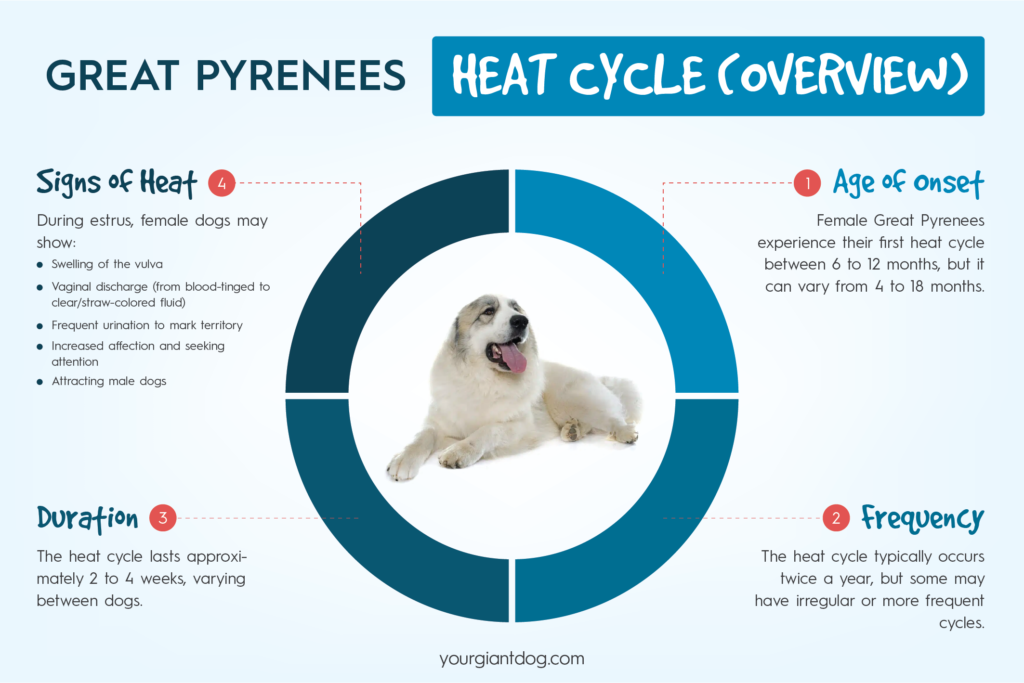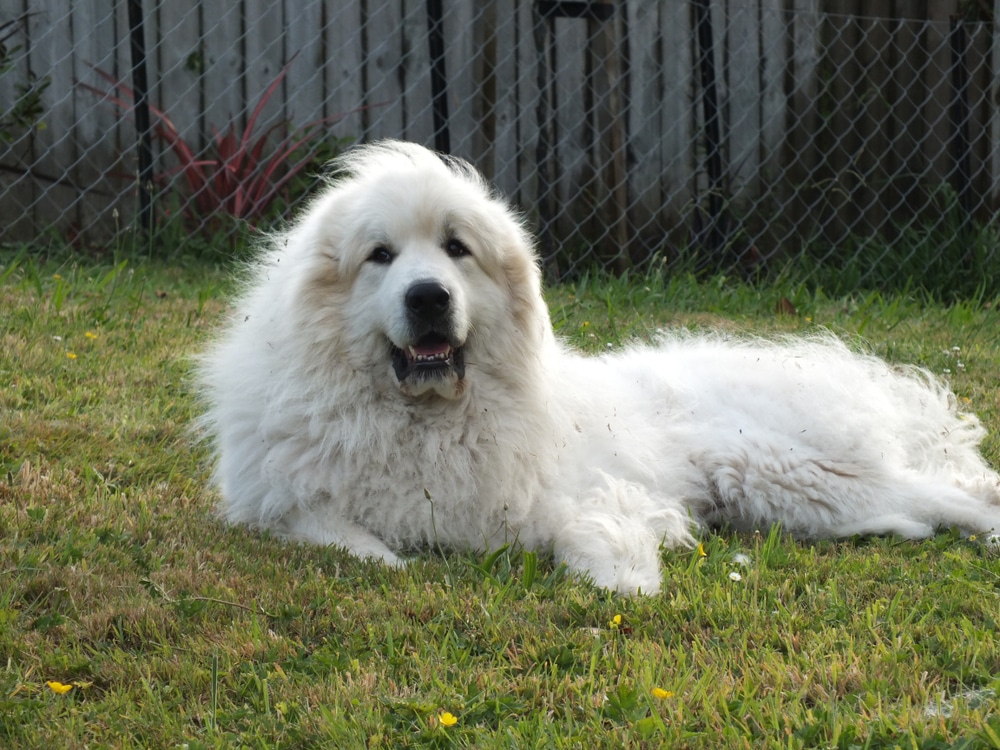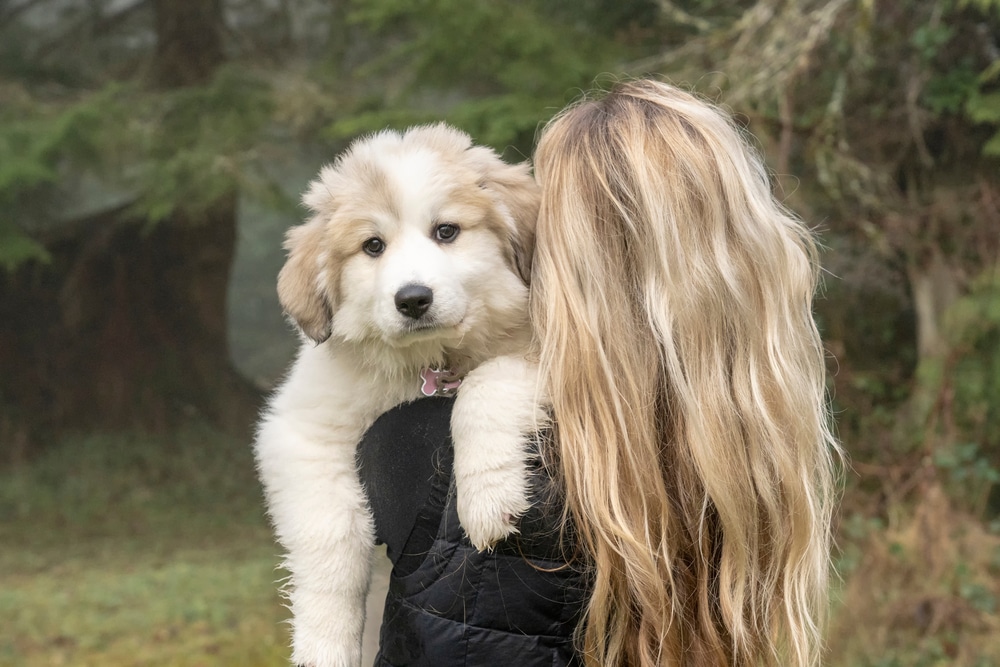The Great Pyrenees are majestic and loyal dogs that make excellent family pets. However, when it comes to their reproductive cycle, it can be difficult to understand when they go into heat. Knowing when your Great Pyrenees Heat Cycle will enter its reproductive cycle is essential for responsible pet ownership.
This complete guide will explore this in detail, including the different stages of the Great Pyrenees going into heat and what to watch out for. We also cover the behaviors to expect from your Great Pyrenees, and how to manage these.
Finally, we provide lots of practical tips to care for your dog while they are on heat, including managing certain risks that all dog owners should be aware of. Read on to find out more!
What Happens Before a Great Pyrenees Heat Cycle?
A dog’s heat cycle is the time when a female dog can become pregnant. The heat cycle usually lasts about two to four weeks. Great Pyrenees Heat Cycle is about twice a year, although some may go into heat more often.
Most Great Pyrenees will have their first heat cycle when they are between six and eighteen months old.
Before a Great Pyrenees Heat Cycle, there are several changes that take place. The first change is an increase in appetite. The dog will start to eat more and may even beg for food more often.
Another change is an increase in urination. The dog may start to mark its territory more often or urinate in places it normally wouldn’t. These are both signs that the dog is ready to go into heat.
A change in behavior may also take place. The dog will usually become more affectionate and cuddly. Some owners say their dogs become more clingy, which can be a problem for owners who have never had a Great Pyrenees before.
“Female Great Pyrenees will go into heat every six months until they are about three years old. After that, they will become seasonal and will only go into heat once a year”.
What are the 4 Stages of a Dog Going into Heat?
There are four stages of a dog going into heat. They are;
Proestrus
Proestrus is the first stage of the mammalian female reproductive cycle. It lasts for about 12 to 16 days and is characterized by increased levels of estrogen.
This surge in estrogen causes the lining of the uterus to thicken and the cervix to soften. These changes prepare the body for pregnancy. During proestrus, ovulation usually does not occur.
Estrus
The estrus cycle is the reproductive cycle of mammals. In mammals, ovulation occurs during estrus. Estrus is characterized by increased levels of estrogen in the body.
This rise in estrogen levels triggers ovulation and causes the lining of the uterus to thicken, making it receptive to implantation by a fertilized egg.
“The length of the estrus cycle varies among species but is typically around 16 days in dogs and 21 days in cats. After estrus, animals enter into a period of sexual dormancy known as anestrus”.
Diestrus
Diestrus is the longest phase of the dog estrous cycle, lasting approximately 60-90 days. During this time, the female dog will experience a decreased interest in mating and will not be receptive to advances from males.
This is the time when she is preparing for pregnancy and is typically not fertile. However, some females may go into heat during this phase if they do not become pregnant.
Anestrus
Anestrus occurs when the ovaries are inactive and no eggs are produced. This can happen for a variety of reasons, including stress, illness, or changes in the environment.
Anestrus is not necessarily permanent, and ovulation may resume after a period of rest. Some animals experience anestrus seasonally, while others may go through it during times of duress.
Check out the video below that explains each of the 4 stages in greater detail!
Typical Behaviors of Female Dogs in Heat
Continuous Licking
When a female dog is in heat, she may exhibit a behavior known as “continuous licking.”
This licking behavior is usually directed at her genital area, and may be accompanied by other signs of heat, such as increased urination, restlessness, and panting.
While some dogs will only lick for a short period of time during their heat cycle, others may lick continuously for several days or even weeks.
If your dog is exhibiting this behavior, it is important to monitor her closely and consult with your veterinarian to ensure that she is healthy and not experiencing any problems.
Erratic Urination
When a Great Pyrenees is in heat, her body goes through a lot of changes. One change that can occur is erratic urination. This means that she may urinate more often than usual, or in places that she normally wouldn’t.
If your dog is acting unusual and you think she may be in heat, take her to the vet to be sure. In the meantime, you can try to confine her to an area where she can t urinate on anything.
If this is not possible, use a product called pheromone sprays that will help attract male dogs away from your female dog.
Extremely affectionate with Male Dogs
During heat, a Great Pyrenees will often become extremely affectionate with male dogs. This is because she is releasing pheromones that attract them. She may also become more playful and energetic.
If you have a Great Pyrenees in heat, you may want to keep her away from male dogs to avoid any unwanted breeding. At least you will know that she is not pregnant.
There are many reasons why a female dog in heat would act this way. Some of these reasons are due to the fact that she is a female dog, and some of these reasons are because she is ready to mate.
The dog may show signs of affection to her owner or other dogs. In some cases, she may become more vocal and playful.
If there is a male dog in the house, he will notice these pheromones, which trigger his own sexual instincts and makes him want to mate with her.
Physical Posture Changes
The Great Pyrenees in heat will experience changes in her physical posture. She may adopt a more submissive stance, with her head and tail lowered. She may also be more clingy and attentive to her owner.
Her body language will be more inviting, and she may solicit more physical contact. These changes are designed to attract male dogs and encourage breeding.
Humping motions
During heat, the Great Pyrenees may start to hump objects or other dogs. This is perfectly normal behavior and is nothing to be concerned about.
Some people believe that humping is a way for the dog to relieve pent-up sexual energy, but this is not the case. Humping is actually a way for the dog to spread their scent and let other dogs know that they are available for breeding.
So, if you see your dog humping objects or other dogs while they are in heat, don’t be alarmed. It’s just their natural way of communicating with the opposite sex.
Noticeable Anxiety and Agitation
The Great Pyrenees may also exhibit noticeable anxiety and agitation during heat. This is due to the hormonal changes that take place during this time. The increased levels of estrogen and progesterone can cause mood swings and irritability in dogs.
This can make them more prone to barking, pacing, and destructiveness. It is important to exercise caution when handling a female dog in heat, as they may be more prone to biting or lashing out.
They may also be more likely to try and escape from their home. It is also important to keep a close eye on your dog during this time as they could get into fights with other dogs or run off after other animals in heat.

How long do Great Pyrenees go into Heat?

Great Pyrenees are notorious for going into heat often and for having a long heat cycle. So, how long do they go into heat?
On average, this breed will go into heat every six to eight months. However, some dogs may go into heat more often, while others may only go into heat once every year or two.
The length of the heat cycle varies from dog to dog, but it typically lasts between three and four weeks.
During this time, the female dog will bleed heavily and will be attracted to male dogs. She will also be very moody and may be more prone to aggression.
How often do Great Pyrenees go into Heat?
When it comes to reproduction, female Great Pyrenees go into heat twice a year on average. However, some females may go into heat more or less often depending on their health and individual reproductive cycle.
The length of each heat cycle varies but is typically around 21 days long. During this time, it is important to keep your female Great Pyrenees away from male dogs to avoid unwanted pregnancies.
“The Great Pyrenees may be more affectionate than usual and her vulva will swell and bleed. If she is not spayed, she may attract male dogs”.
How long does a Great Pyrenees bleed during Heat?
The Great Pyrenees will bleed during heat for about 2-4 weeks. During this time, the dog may be irritable and want to be left alone.
It is important to keep the dog away from other dogs during this time so that there is no fighting and no chance of getting pregnant.
After the weeks are up, the dog will be back to normal and can be around other dogs again.
How to Care for a Great Pyrenees during Heat?
The Great Pyrenees in heat needs extra care and attention. Here are some tips on how to care for your dog during this time:
1. Keep your dog away from other dogs. This is to prevent her from getting pregnant and to avoid any fights with other dogs.
2. Take her for walks more often. This will help her release any pent-up energy and keep her calm. Remember, a bored dog will usually exhibit traits that you may not approve of.
3. Be patient with her. She may be moody and irritable during this time, so it’s important to be understanding.
4. Keep an eye on her diet. She may want to eat more or less during this time, so make sure she’s getting the nutrition she needs.
5. Give her plenty of love and attention. She may need more of this because she is feeling depressed.

6. If she starts to obsess about food, it could be a sign that she’s pregnant or has an infection. Make sure she visits the vet if this happens.
7. Watch for other signs of pregnancy, like nesting and pacing in circles.
8. Watch for other signs of infection, like coughing or sneezing, runny eyes or nose, a loss of appetite, or lethargy. If you notice any of these symptoms, take them to the vet immediately.
How to Prevent a Great Pyrenees from getting Pregnant during Heat?
Preventing the Great Pyrenees from getting pregnant during heat is important for the health of the dog and for the litter that may be born. Knowing when the Great Pyrenees will go into heat is the first thing to be conscious of.
There are several other factors to be aware of to prevent pregnancy, including spaying, keeping the dog away from intact males, and using contraception.
Spaying is the most effective way to prevent pregnancy in the Great Pyrenees. This surgical procedure removes the ovaries and uterus, making it impossible for the dog to become pregnant.
Also, using contraception can help to prevent pregnancy if used correctly. There are a few different types of contraception, including the birth control pill, an injection that lasts for several months, and a topical cream.
You may be interested in – The Ultimate Great Pyrenees Guide – All Questions Answered!

